Ancient Chinese Horses
Introduction
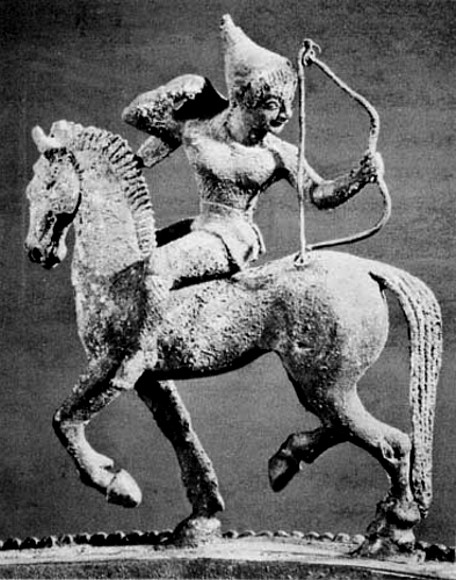
For millennia man has been familiar with horses and these friendly
animals have significantly advanced the civilization right up to the early 20th
century. At first, horses were hunted for food, as revealed by the depositories of
their bones at the site of prehistoric human settlements in southern France . On
the wall of a cave in Lascaux, France, one drawing shows a horse with a small
head, a thick mane, slender legs and a full, fat belly that is struck by an arrow and
tracings of two possible projectiles (c.15000 BC). On other cave paintings in
Spain and France, horses show a short, broad head with a thick straight mane
and a hairy jaw and legs with feathery hairs. One colour drawing shows a dark
horse with a white muzzle. The horses in these drawings resemble the features
of two primitive horses - the Asian Wild Horse and the Tarpan.
About 4000 BC, it is believed horses were first domesticated by the nomadic
Aryan tribes in the Great Steppes to the north of mountains that border the
Caspian and Black Seas. When these tribes expanded east, west and south, the
domestication of horse began to spread over the world. In 2500 BC, chariots of
four solid wheels were drawn by wild asses in the army of Sumerians in
Babylonia. About 1600-1300 BC, an Indo-European tribe called Hittites from
Turkey assembled a powerful cavalry. By 1600 BC the Egyptians made swift
chariots that harnessed a team of four desert horses, which had a gazelle like
body and long slender legs.
Amazon Warrior Riding Bareback, c.500 BC [1]
About 1000 BC, a horse-riding nomadic nation known as the Scythians emerged from the central Asia and roamed into the Egypt and the Eastern Europe. The eastern limit of the Scythian territories touched the western Siberia. In Pazyryk on the Altay Mountain, horse skeletons were discovered in the Scythian tombs. Among gold ornaments in the tombs, there is a colourful Persian carpet depicting a rider on a tall horse similar to that of the Amazon archer (Photo).
Qin Dynasty
In ancient China, horses were tamed and raised like livestock and some wild
animals such as elephants. The existence of these farm animals were recorded
on the oracle shells of tortoise in the Shang Dynasty (1766-1122 BC), and horse
riding probably occurred in the earlier periods. Ancient history books mentioned
that a king (King Huang) sat on horses and cattle and hauled heavy loads in
about 2205 BC. Then in about 1122 BC, King Chou led 300 war chariots, 3000
elite guards and 45000 armoured soldiers to overthrow the Shang Dynasty. Up
to the Warring States period (476-221 BC), chariots remained the main
transports to charge the infantry lines. The tactics of combining the slow and
stable chariots with the foot soldiers was effective on the Chinese plain, which is
bisected by many rivers and hills. On the contrary, the Chinese warlords
adopted a defensive strategy to build walls to keep out the swift horsemen of
Huns.
China had already mastered the horsemanship and had perfected the skills to
harness and saddle the horses in the early 1st millennium, BC. When Emperor
Qin Shi Huang established the Qin Dynasty (211-206 BC) , his mighty army had
deployed disciplined formations of cavalries and chariots. However, the
defensive strategy against the Huns was still kept by keeping his forces mainly
behind the Great Wall.
The Terra-Cotta figures of the Tomb of Emperor Qin Shi Huang have provided a
realistic model of the Qin army. The Terra-Cotta and bronze horses are
apparently of the Asiatic origin. The Terra-Cotta horse is small and has a board
short body, strong short legs, and full hindquarters with a strong front. The
shoulders are slightly straight and can provide the power to pull a heavy load.
The large head is long with a convex profile, the large alert eyes are set high, and
the short upright mane is the next distinctive feature. In comparison with the
surviving specimen of the Asian Wild Horse [2], the Terra-Cotta horses are likely
to be a domestic variation of the wild horse.
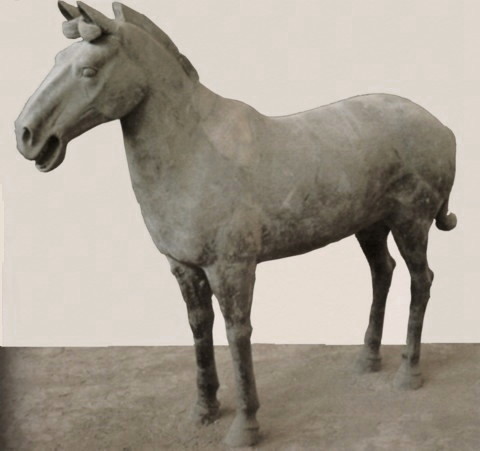
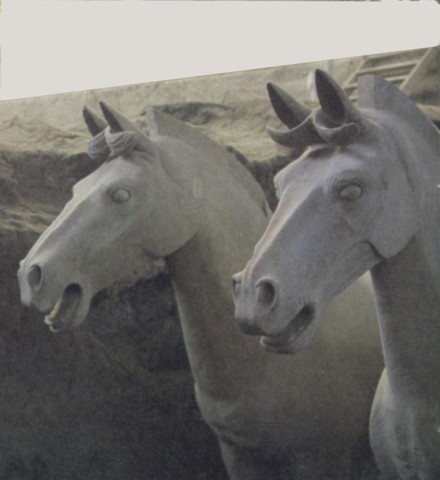
Terra-Cotta horses excavated from the tomb of Emperor Qi Shi Huang (259-210 BC)
near the city of Xi'An, Shaanxi Province.
Western Han Dynasty
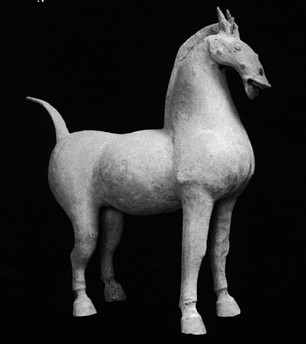
In the Western Han Dynasty, Emperor Wudi (141-87 BC) started to pursue an aggressive strategy to expel the Huns from China. During the early campaigns, the emperor found out that his slower troops had no match to the Hun horsemen in the open terrain beyond the Great Wall. To build up a mobile force, he sought for more horses and, importantly, for swifter horses. He thus sent envoys to Bactria to buy breeding stocks of Turkestan and Fergana. The horse trade flourished between the Central Asian nations and the Han Dynasty for several years. Then, the ruler of Fergana killed an envoy of Emperor Wudi and suspended the trade. In 104 BC, Wudi sent a large expedition force of over 40,000 soldiers to Fergana to take the needed horses by force. In the end the Han's army obtained several thousands of horses. Among these horses, there was a herd of tall fine horses that were known as Heavenly Horses and excreted bloody colour sweat or bloody sweat. This puzzling phenomenon was often seen on the shoulder and the back of the Fergana horses. One easy answer might be the sweat mixed with the blood from saddle sores or caused by a heavy saddle. Now, the scientists have unanimously agreed to a consensus that the bleeding is caused by a subcutaneous parasite on the skin of the upper body of the horse.
Pottery figure of Western Han dynasty
In Western Han Dynasty (206 BC-AD 8), the new horses became the status symbol of prestige and wealth. These horses were portrayed in pottery figurines, which were placed in the tombs of officials. In a tomb in Shensi Province (c. 1st century BC), the pottery figures of horses and riders show a tall horse with a small elegant head, a long tapering neck, a long back, a shallow body, long legs, and thin mane – the characteristics of Fergana horse.
Heavenly Horse
Some researchers think that the Heavenly Horses were the descendents of horses brought by Alexander the Great into central Asia while Alexander's horses were cross-bred from imported stocks. The King Philip of Macedonia had imported 20,000 Scythian mares [3] to cross breed the local stock of Thessaly. Then his son, Alexander the Great (356-323 BC), imported another herd of 50,000 Arabian horse from Persia. One of these cross-bred horses was the legendary Bucephalus, the mount of Alexander. The name of horse means ox head referring to the broad forehead and slightly concave profile The pictures below show a stocky breed for riding and a slender breed for chariots. The horses of the Amazon Archer and the Greek chariot both have a long shallow body, a long thin neck, and a small head. The pictures also show the straight mane on one of the four chariot horses and the Scythian horse.


Friezes: Athens, c.440 BC. (Left) Siphnian treasury at Delphi, c.525 BC. (Right)
Going back to history, one can examine the available horse types, scientifically
named Equus Caballus. At the end of the Ice Age, there were four basic types of
horses which developed their features in accordance to the adaptation of the
climates and terrains. The fist type is the oldest Celtic or Atlantic Ponies that
lived in northwest Europe. The second type resembled to the Asian Wild Horse,
but it had a 64 of chromosome count while the Asian Wild Horse has a count of
66. This type includes the bigger and heavier North European and North Asian
Forest Horse that inhabited on the tundra or the forests. The third type is of horse
size and lived in the dessert of Central Asia. This type is the Eastern or Oriental
Horse that had influenced the evolution of most present-day breeds and types.
The last type is also of horse type and lived in the dessert of Western Asia. The
small horse is thought to have been an ancestor of the Arab.
From the Fergana valley where Emperor Wudi obtained the rare Heavenly Horse,
these cherished horses must thus have belonged to either the third or the fourth
type of horses. These types included two small horses of pure breed, namely the
Caspian and the Tarpan. One choice is the tall Persian Arab, though it does not
include all the features of the tall horse in question. The other choice falls on
Akhal-Teké [4] that roamed the vast expanse of northern Asia and included
features comparable to the anatomy of pottery horses. Most of horse experts
consider that the Heavenly Horse is an Akhal-Teké or a derivative of his.
Eastern Han Dynasty
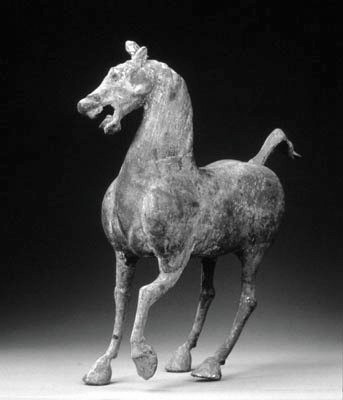
After about two centuries, the bronze figures of Eastern Han Dynasty (AD 24-220) reveal some marked differences in anatomy with the precedent horses. The bronze horses excavated in 2nd century AD in Gansu Province seem to match the description of the Arabic horses, in that both have a deep girth, a small head, a typical "dished" face, a crested neck, a long mane, and a tail carried high and arched.
Bronze figure of Eastern Han dynasty, 2nd century AD.
Subsequent Dynasties
By the Tang Dynasty of the 7th century, over 750,000 horses were kept in horse farms on the northern steppes. The cross-breeding probably improved the Chinese horses.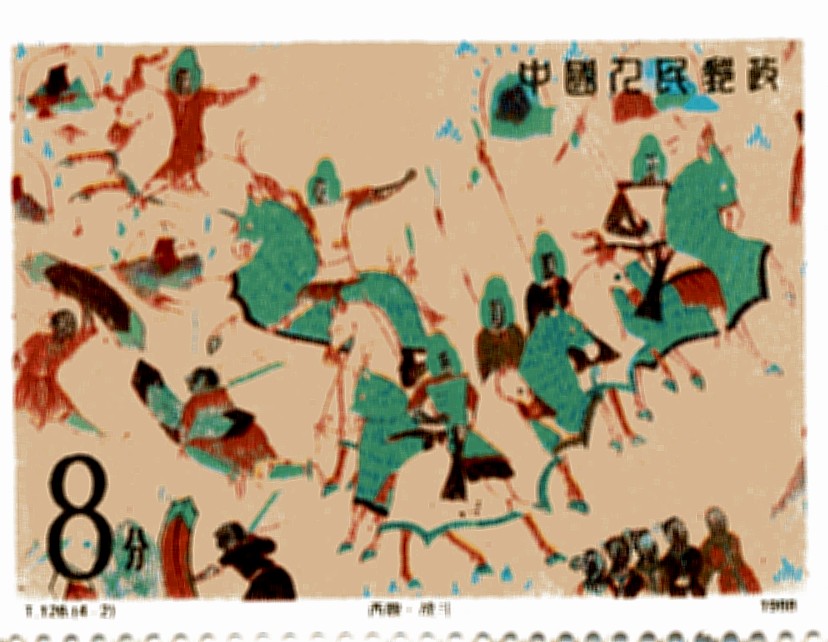
The Tang horses had a small head with muscular crested neck, a compact body, strong long legs, very powerful rounded hindquarters. The thick flowing mane was often clipped and was accompanied by a short clipped tail bound by bandages. The war horses of the Southern and Northern Dynasties (AD 420- 589) are known to wear a full amour suit made of small metal plates and a metal mask. By now, the stirrups were used by horseman in the Tang dynasty.
Armour-clad horses of Western Wei Dynasty (AD 534-557) — Cave paintings at Dunhuang
1988 Chinese Postage Stamp
In the Zaoling Tomb, there were six friezes of rock sculptures showing the six
steeds of Emperor Li Shimin (r. 626-649). The artistic friezes depicted the lively
actions of the horses, who followed the campaigns of the emperor. Two of these
steeds were killed in battle and the other two were wounded.
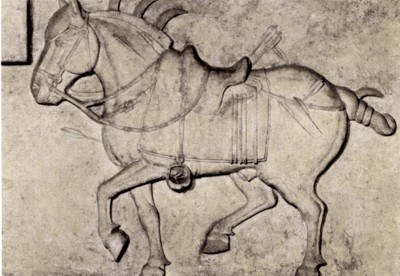 In a battle the emperor was cut from his troops and his mount (named Saluzi) were struck by
several arrows. One of his general galloped to the emperor and pulled out the
arrows from the horse. At the end the horse managed to carry the emperor back
to safety. One of the frieze depicts the general standing in front of the calm horse
and pulling an arrow embedded in the horse's breast. Here, the picture (left)
shows the other wounded horse (named Quanmaowa). The friezes showing
Saluzi and Quanmawa are now kept in the museum at the University of
Pennsylvania in Philadelphia, USA. The other four friezes are kept in the
mausoleum of Li Shimin in China.
In a battle the emperor was cut from his troops and his mount (named Saluzi) were struck by
several arrows. One of his general galloped to the emperor and pulled out the
arrows from the horse. At the end the horse managed to carry the emperor back
to safety. One of the frieze depicts the general standing in front of the calm horse
and pulling an arrow embedded in the horse's breast. Here, the picture (left)
shows the other wounded horse (named Quanmaowa). The friezes showing
Saluzi and Quanmawa are now kept in the museum at the University of
Pennsylvania in Philadelphia, USA. The other four friezes are kept in the
mausoleum of Li Shimin in China.
Frieze - Quanmaowa, mount of Emperor Li Shimin

The horses shown by paintings and ceramics figures portray a tall and very
muscular form, especially of the hindquarters; however they show the small
elegant head and the long legs of the Akhal-Teké.
It should be noted the importation of horses from Central Asia was still flourishing
in the Tang Dynasty.
Taiwanese Postage Stamp
The next stamp shows a Dayuan (Fergana) horse painted by Giuseppe Castiglione (a Jesuit, AD 1688-1760), who was born in Milan, Italy, went to China in 1705 and was admitted into the Qing court. He had taken up a Chinese name as Lang Shi-Ning. He mastered the techniques of traditional Chinese painting and introduced the European style into his paintings. His works including paintings of dogs, monkeys, birds and horses; his most famed painting is a 25 foot scroll of one hundred horses.
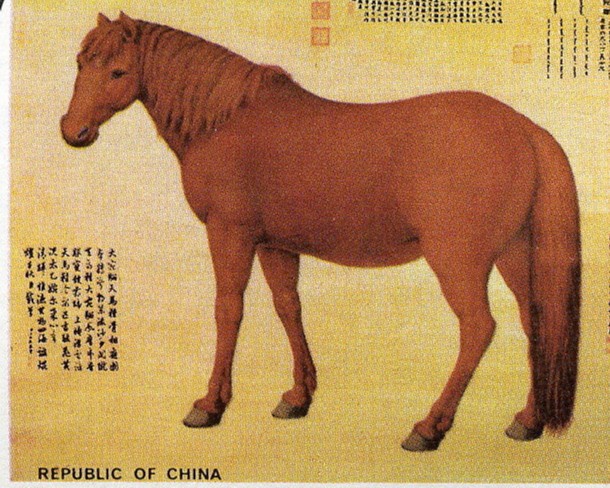
The 1973 stamp of 8.00 denomination is issued by Taiwan (China) in a set of ten
Notes
- Amazon and Horse
The Scythian archer shows a "Parthian shot" usually made at the gallop over the horse's tail. This shooting technique had been effectively used by the Parthian and the Mongol. The figurine is from the lid of a bronze cauldron of Etruscan origin excavated at Santa Maria de Capua Vetere, 6th century BC. The pubic domain is given the permission to copy, distribute and/or modify The copyrighted photograph under the terms of the GNU Free Documentation License. The copyright holder of one of the pictures is The Circle of Ancient Iranian Studies (CAIS).
- Asian Wild Horse
 The horse (also called Prezewalski's Horse) is the only truly primitive breed that
is still surviving in the world. This wild horse was discovered by Colonel
Preswalski on the western edge of the Gobi desert in Mongolia in 1879. This
breed has not changed much after the Ice Age. The head is long and heavy with
a convex profile and a pair of set-high big eyes. The body is broad and short with
short legs. The harsh mane is upright and there is little forelock. The tail is long
and black. The colour is dun traditionally and the muzzle is white. The back has a
thin dorsal stripe of darker hairs and the lower legs are black sometimes with
zebra markings. The horse is of pony size in the range of 11 to 14 hands; the
height in hands (10 cm or 4 in) is measured from the withers to the ground.
The horse (also called Prezewalski's Horse) is the only truly primitive breed that
is still surviving in the world. This wild horse was discovered by Colonel
Preswalski on the western edge of the Gobi desert in Mongolia in 1879. This
breed has not changed much after the Ice Age. The head is long and heavy with
a convex profile and a pair of set-high big eyes. The body is broad and short with
short legs. The harsh mane is upright and there is little forelock. The tail is long
and black. The colour is dun traditionally and the muzzle is white. The back has a
thin dorsal stripe of darker hairs and the lower legs are black sometimes with
zebra markings. The horse is of pony size in the range of 11 to 14 hands; the
height in hands (10 cm or 4 in) is measured from the withers to the ground.
This species were extinct in the wild, because they had been ruthlessly hunted for meat for centuries and they had cross bred with the runaways of domestic herds. By 1969, only several hundreds of these horses existed in zoos and forest reserves. In 1992, 16 Wild Horses were re-introduced to a steppe reserve in Mongolia by a Dutch foundation. By 1998, there were about 60 such horses in Mongolia and about 1,450 living elsewhere.
- Scythian Horses
 From excavation of Scythian tombs, there were two types of horses, one is taller
and rarer and the other is smaller and more common. The tall horse might be
assumed to be the ancestor of Akhal-Teké horse. Not enough literature can
provide detailed information about the small Scythian horses, but the Scythian
nomads had introduced a small pony called Tarpans to the Ukrainian steppes.
From excavation of Scythian tombs, there were two types of horses, one is taller
and rarer and the other is smaller and more common. The tall horse might be
assumed to be the ancestor of Akhal-Teké horse. Not enough literature can
provide detailed information about the small Scythian horses, but the Scythian
nomads had introduced a small pony called Tarpans to the Ukrainian steppes.
Evidence suggests Tarpan was evolved from a cross of Western Asia and Eastern Asia types of primitive horses. The small horse had a long broad head and had about 13 hands in height. The other features resemble the Prezewalski's Horse. Their body colour is mouse to brown with dorsal stripe an zebra stripes on forelegs and inner thighs. Tarpans had also been hunted for meat and had mated with domestic stock. The last wild Tarpan died in the late 19th century and the last Tarpan died in a farm in 1876.
The new stock is a human recreation by carefully cross breeding several horse types to simulate the appearance of Tarpan. A small herd of "Tarpan" now roams freely in a reserve in Poland.
- Akhal-Teké
 Description: Akhal-Teké has a light and elegant build; the body is long, lean and narrow
through the chest. The neck is straight, long and often thin, set high on excellent
sloping shoulders. His mane is sparse and short with little forelock.
The skin is very thin with a short, fine and silky coat, often with a metallic glow.
The normal height is between 15 and 16 hands and the weight between 900 to 1100 pounds.
Description: Akhal-Teké has a light and elegant build; the body is long, lean and narrow
through the chest. The neck is straight, long and often thin, set high on excellent
sloping shoulders. His mane is sparse and short with little forelock.
The skin is very thin with a short, fine and silky coat, often with a metallic glow.
The normal height is between 15 and 16 hands and the weight between 900 to 1100 pounds.
Akhal-Teké developed an tenacious stamina and an ability to withstand great extremes of temperature. He can sustain without fresh forage in the arid desert for months. Akhal Teké is an excellent riding horse that is very fast, resilient and bold and was the prized mount of Scythian warriors.
His body provides a soft, elastic stride to his rider, and the long back might make the body easier in turns and in maneuver. Nevertheless, this anatomy has several weaknesses. First, the long supple back makes the ride comfortable but tends to make the ride less stable. Then the hindquarters are muscular but maybe not enough to compensate the frame of a long body. The gallop might be hindered when the horse carries a heavier load on tough or muddy ground. The head that is often above the hand level and the long neck need the rider to exercise more controls on the rein in full galloping. Then, the shallow chest might not be able to supply adequate oxygen in strenuous workouts. Overall, Akhal-Teké requires a superior horseman to appreciate the powers of this breed.
[Top|Middle] of Page